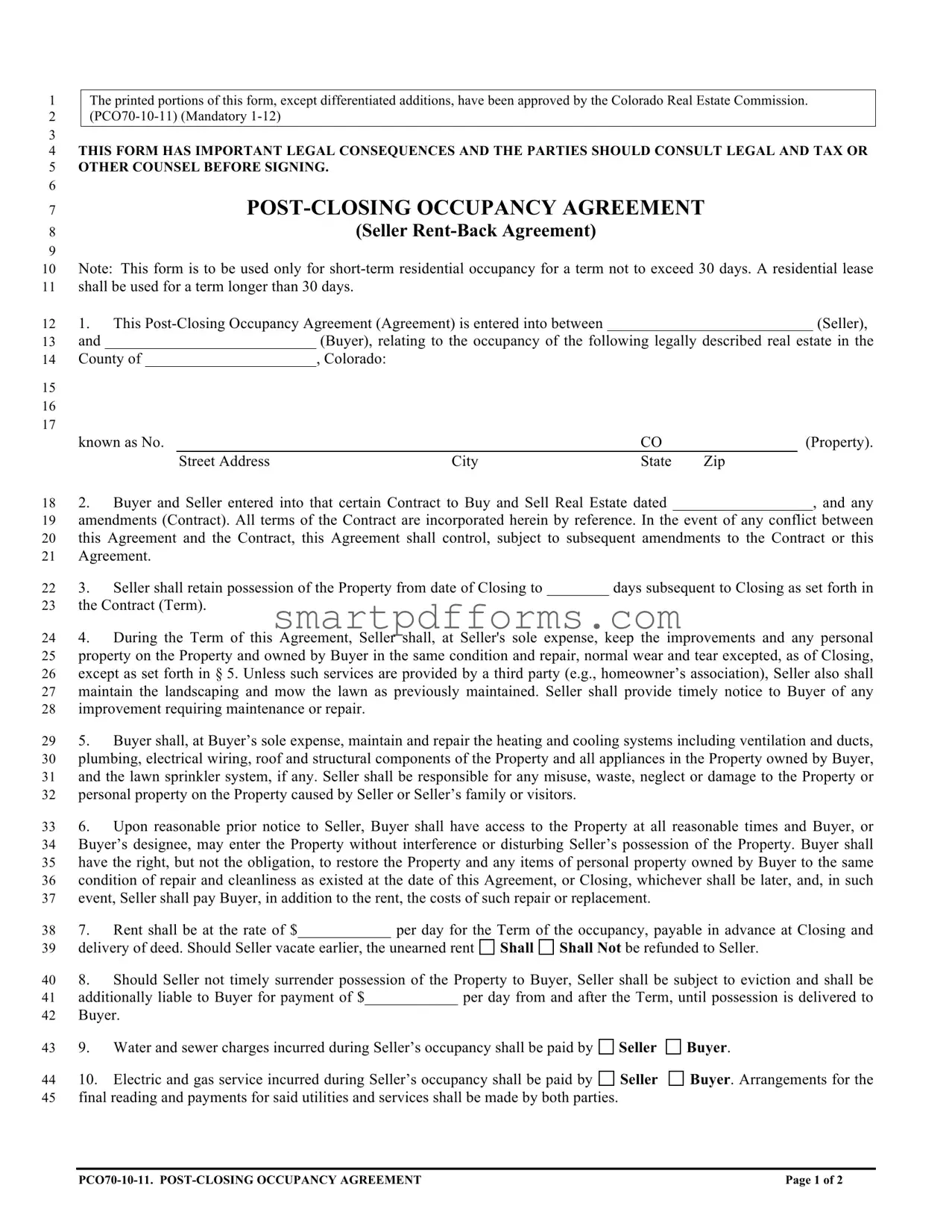1The printed portions of this form, except differentiated additions, have been approved by the Colorado Real Estate Commission.
2 (PCO70-10-11) (Mandatory 1-12) 3
4 THIS FORM HAS IMPORTANT LEGAL CONSEQUENCES AND THE PARTIES SHOULD CONSULT LEGAL AND TAX OR 5 OTHER COUNSEL BEFORE SIGNING.
6
7
8
9
10Note: This form is to be used only for short-term residential occupancy for a term not to exceed 30 days. A residential lease
11shall be used for a term longer than 30 days.
12 |
1. |
This Post-Closing Occupancy Agreement (Agreement) is entered into between |
|
|
|
(Seller), |
13 |
and |
|
|
|
(Buyer), relating to the occupancy of the following legally described real estate in the |
14 |
County of |
, Colorado: |
|
|
|
|
15 |
|
|
|
|
|
|
|
|
|
16 |
|
|
|
|
|
|
|
|
|
17 |
|
|
|
|
|
|
|
|
|
|
known as No. |
|
|
CO |
|
(Property). |
|
|
|
|
Street Address |
City |
State |
Zip |
182. Buyer and Seller entered into that certain Contract to Buy and Sell Real Estate dated __________________, and any
19amendments (Contract). All terms of the Contract are incorporated herein by reference. In the event of any conflict between
20this Agreement and the Contract, this Agreement shall control, subject to subsequent amendments to the Contract or this
21Agreement.
223. Seller shall retain possession of the Property from date of Closing to ________ days subsequent to Closing as set forth in
23the Contract (Term).
244. During the Term of this Agreement, Seller shall, at Seller's sole expense, keep the improvements and any personal
25property on the Property and owned by Buyer in the same condition and repair, normal wear and tear excepted, as of Closing,
26except as set forth in § 5. Unless such services are provided by a third party (e.g., homeowner’s association), Seller also shall
27maintain the landscaping and mow the lawn as previously maintained. Seller shall provide timely notice to Buyer of any
28improvement requiring maintenance or repair.
295. Buyer shall, at Buyer’s sole expense, maintain and repair the heating and cooling systems including ventilation and ducts,
30plumbing, electrical wiring, roof and structural components of the Property and all appliances in the Property owned by Buyer,
31and the lawn sprinkler system, if any. Seller shall be responsible for any misuse, waste, neglect or damage to the Property or
32personal property on the Property caused by Seller or Seller’s family or visitors.
336. Upon reasonable prior notice to Seller, Buyer shall have access to the Property at all reasonable times and Buyer, or
34Buyer’s designee, may enter the Property without interference or disturbing Seller’s possession of the Property. Buyer shall
35have the right, but not the obligation, to restore the Property and any items of personal property owned by Buyer to the same
36condition of repair and cleanliness as existed at the date of this Agreement, or Closing, whichever shall be later, and, in such
37event, Seller shall pay Buyer, in addition to the rent, the costs of such repair or replacement.
387. Rent shall be at the rate of $____________ per day for the Term of the occupancy, payable in advance at Closing and
39 |
delivery of deed. Should Seller vacate earlier, the unearned rent |
Shall |
Shall Not be refunded to Seller. |
408. Should Seller not timely surrender possession of the Property to Buyer, Seller shall be subject to eviction and shall be
41additionally liable to Buyer for payment of $____________ per day from and after the Term, until possession is delivered to
42Buyer.



 Buyer
Buyer















 ________________
________________